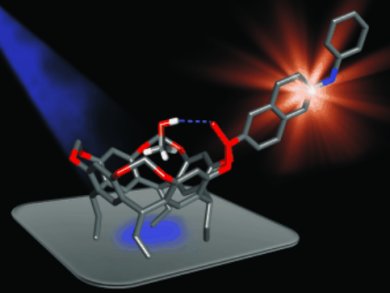The ability to sense and monitor different chemical species in the gas phase has applications that range from detecting environmental pollutants and hazardous chemicals, to disease diagnosis from volatiles present in breath. Most organic and polymer-based sensors detect analytes by polarity.
Enrico Dalcanale and co-workers, Università di Parma, Italy, have used an H-bonding approach to detecting short chain alcohols with a phosphonate cavitand. The alcohols H-bond to the P=O group of the cavitand, which induces a change in the fluorescence emission of the attached fluorophore. The cavitand has a strong preference for C1–C4 alcohols and is sufficiently selective to discriminate between alcohols on the basis of a single methylene unit difference.
This approach could allow the discrimination of analytes by chemical class, rather than by polarity.
Image: (c) Wiley-VCH
- Highly Selective Chemical Vapor Sensing by Molecular Recognition: Specific Detection of C1–C4 Alcohols with a Fluorescent Phosphonate Cavitand
F. Maffei, P. Betti, D. Genovese, M. Montalti, L. Prodi, R. De Zorzi, S. Geremia, E. Dalcanale,
Angew. Chem. Int. Ed. 2011.
DOI: 10.1002/anie.201100738




